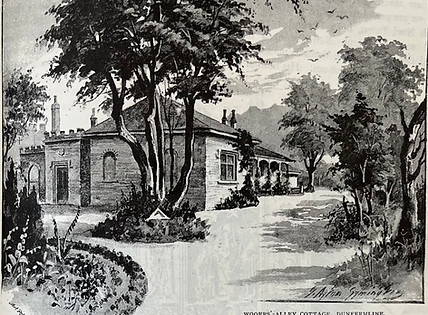

The Patons of Dunfermline
"These Patons were always a marked family, and have had genius hovering about their pretty home for generations... touching the heads and hearts of father, sons, and daughters with its creative wand"
ANDREW CARNEGIE
About the Paton Family
The Patons were a family living in Dunfermline in the mid 19th century,
each becoming artists of national importance in Scotland's cultural history.

Image: Sir Joseph Noël Paton (1866), albumen carte-de-visite, by Thomas Annan.
©The National Portrait Gallery, Creative Commons License.
The most well-known of the family, Sir Joseph Noël Paton (1821-1901), was one of the most prominent artist of the19th century in Scotland. He started working for his father as a damask designer, later becoming an artist renowned for painting fairies and religious scenes, many still on display in the major galleries around Scotland. He was friends with many of the artists of the Pre-Raphaelite Brotherhood, including Sir John Everett Millais, Dante Gabriel Rossetti and William Holman Hunt, as well as the art critic John Ruskin. He became Queen Victoria’s Painter & Limner for Scotland, and was one of the only artists permitted to paint her during her early mourning of Prince Albert. In later life he designed the stained glass windows for Dunfermline Abbey, commissioned by Andrew Carnegie.

Image: Amelia Robertson Hill, née Paton (1860s), albumen carte-de-visite, by Peter Lothian.
©The National Portrait Gallery, Creative Commons License.
His sister Amelia Robertson Hill, née Paton (1821-1904), was a successful sculptor who started a career in her late 30s, carving marble busts of the great and the good of Fife and later carved statues for a variety of locations around Scotland including large statues of Robert Burns in Dumfries and David Livingstone in Edinburgh, and three figures for the Scott Monument. She married pioneer photographer David Octavius Hill and was close friends with Andrew Carnegie.

Image: Waller Hugh Paton (1860s), albumen carte-de-visite, by Nisbett & Lothian.
©The National Portrait Gallery, Creative Commons License.
Their younger brother Waller Hugh Paton (1828-1895), started out designing damasks, then became a prolific landcape artist who painted scenes from all over Scotland. He was credited at the time for being one of the first artists of his generation in Scotland to paint ‘en plein air’ (painting an entire canvas on location outdoors). His work is also on display at some of the major galleries in Scotland.

Image: Joseph Neil Paton, oil painting by unknown artist.
Private Collection.
Their father, Joseph Neil Paton (1797-1874), was a well respected damask designer and 700 of his designs are still in the V&A in London. A collector of Historical Scottish artefacts, he opened his small gothic-revival style home, Wooers' Alley Cottage, as a museum for the public. Much of his collection is now in the National Museum of Scotland. One of the most popular items in his display was the 'toe bone' (or metatarsal) of Robert the Bruce, collected at the time of the exhumation of Bruce’s body during the building of the new abbey. He was also known for experimenting with religion and later becoming a Swedenborgian Minister.

Image: 1976 Reprint of 'The History of Dunfermline, gather'd from good autority, personal kno'ledge and hear-say',
by D.Patton (David Paton).
Joseph Neil Paton's father, David Paton (1766-1844), also a native of Wooers' Alley, had been well known in Dunfermline as a weaver, inventor, author and town drummer. He invented a printing press which he used to print his book titled: 'The History of Dunfermline gather'd from good aut'ority, personal kno'ledge and hear-say'. It is thought that he sparked his son's interest in collecting artefacts, having been an avid collector himself.

Image: Wooers' Alley Cottage, the home of the Patons until 1874 and demolished c.1926.
From Atalanta Magazine 1893.
The mossy rocks, meandering stream, wild flowers and twisting ivy-covered trees of the Wooers' Alley garden featured throughout many of the Patons' most important works of art, including Sir Joseph Noël Paton's fairy paintings, Amelia Robertson Hill's statue of Robert Burns, and Joseph Neil Paton's damask designs.
On hearing about the death of Joseph Neil Paton in 1874, Andrew Carnegie wrote:
“I cannot describe the effect the sad intelligence had upon us… ‘Joseph Paton’ had been since my infancy indeed a household word with us”.
Although the Patons were once well known nationally in Scotland, their names have now largely been forgotten. But as you explore our trail of the Patons around the City of Dunfermline, you will discover the many works of art and artefacts which the Paton family have left behind. We hope you enjoy finding them!